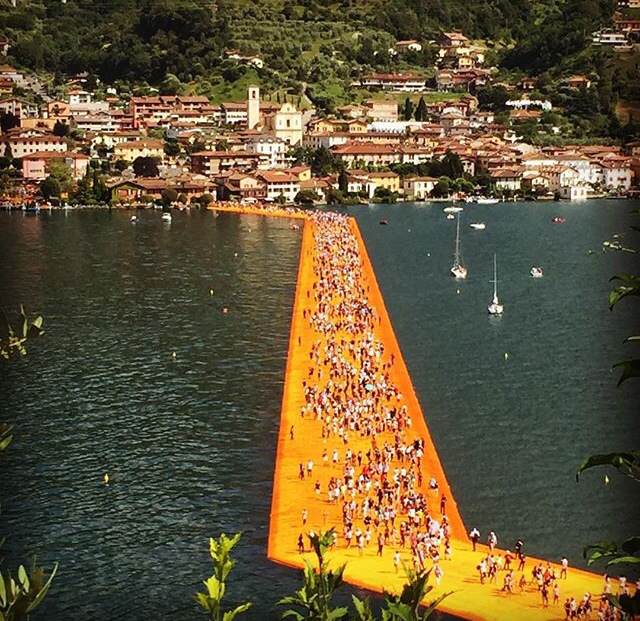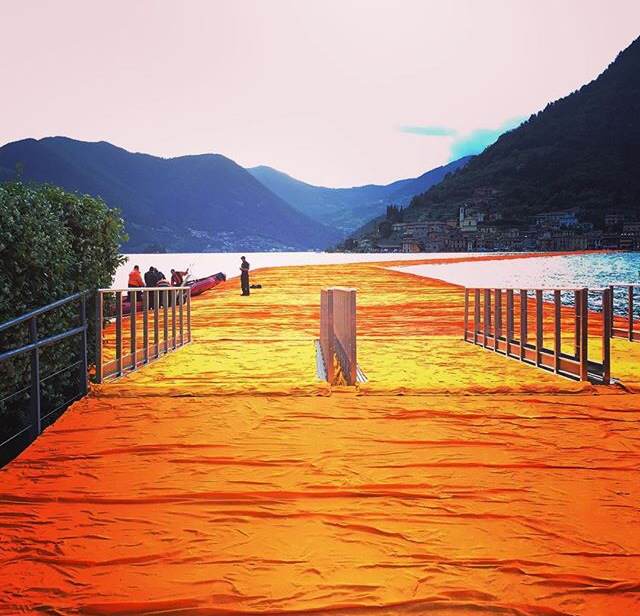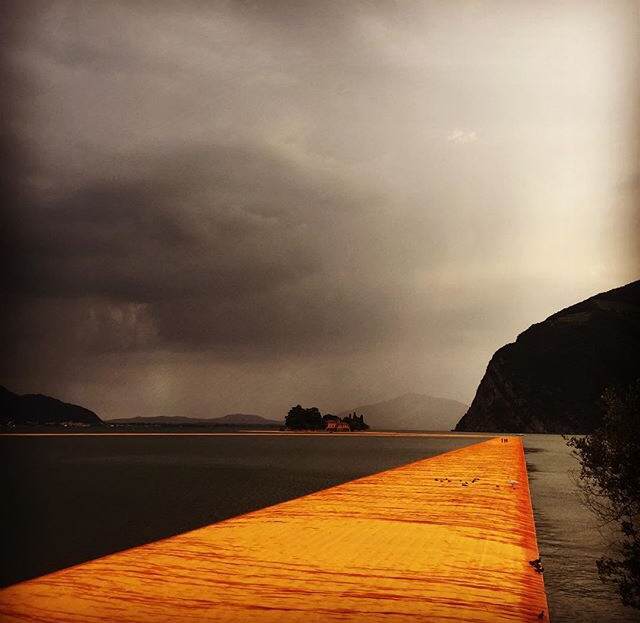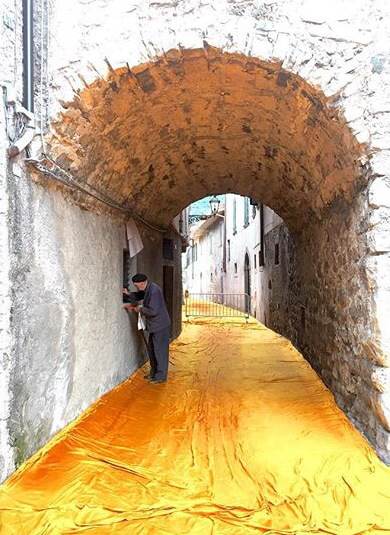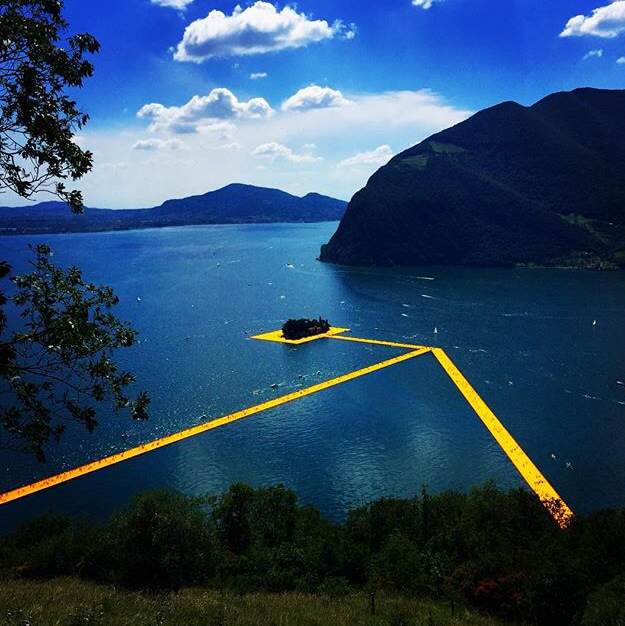June 18 through July 3, 2016 – For sixteen days, Italy’s Lake Iseo, Lago d’Iseo, is being reimagined. 100,000 square meters of shimmering yellow fabric, carried by a modular floating dock system of 220,000 high-density polyethylene cubes, undulate with the movement of the waves as ‘The Floating Piers’ rise just above the surface of the water. Visitors can experience this work of art by walking on it from the town of Sulzano to Monte Isola and to the island of San Paolo, which is framed by The Floating Piers. The mountains surrounding the lake offer a bird’s-eye view of The Floating Piers, exposing unnoticed angles and altering perspectives. Lake Iseo is located 100 kilometers east of Milan and 200 kilometers west of Venice.
“Like all of our projects, The Floating Piers is absolutely free and accessible 24 hours a day, weather permitting,” Christo, 81, a Bulgarian-born American, said of his project. “There are no tickets, no openings, no reservations and no owners. The Floating Piers are an extension of the street and belong to everyone.”
Opened to the public this Saturday, June 18, on a bright sunny summer day stepping out on the floating walkway of puckered yellow-orange nylon fabric, designed to change color according to the time of the day and the weather. By noon, it was filled with locals and visitors from afar. Several art aficionados having travelled from Basel, Switzerland after the opening of the Art Basel contemporary art fair. But by late afternoon, the piers had to be evacuated as a severe thunderstorm was brewing up. A 3-kilometer-long walkway was created as The Floating Piers extend across the water of Lake Iseo. The piers are 53 feet wide (16 meters) and approximately 35 centimeters high with sloping sides. The fabric continues along 2.5 kilometers of pedestrian streets in Sulzano and Peschiera Maraglio.
“Those who experience The Floating Piers will feel like they are walking on water – or perhaps the back of a whale,” said Christo. “The light and water will transform the bright yellow fabric to shades of red and gold throughout the sixteen days.”
Shoes are optional, and it’s probably worth taking them off, at least for a moment, to feel the fabric’s texture. (There is a layer of felt beneath the saffron cover.) When wet, the walkway is a little squishy; when sunny, it feels warm to the toes. In the spring and summer of 2014, Christo, Vladimir Yavachev – Operations Director, Wolfgang Volz – Project Manager, and Josy Kraft – Registrar/Curator, scouted the lakes of Northern Italy. Along with Project Director Germano Celant, they found Lake Iseo to be the most inspiring location. Getting the walkway to both gently undulate and remain securely affixed to the uneven lake bottom was a feat that has occupied engineers, construction companies, French deep-sea divers and even a team of Bulgarian athletes drafted over the past two years.
“I think this is a record in the history of Christo’s special projects because he and the team realized it in 22 months; normally it takes decades,” the curator Germano Celant, the project’s director, said. “So I will say that it’s an Italian and American miracle at the same time.”
Christo said it was about positively exploiting “the incredible chemistry of humans” from all walks of life, each member of the team focusing energy on “something that does not exist” — to the point where it does. He was also relieved that there was never a discussion with officials about installing a safety fence along the sides of the walkway, allowing visitors to walk to the edge of the water. “The moment you have a parapet, forget it,” he said, the feeling of walking on water is gone. Other concerns about the ability of a small lake community to deal with the avalanche of visitors that the walkway is expected to draw — an estimated 40,000 people a day — appear to have been muted for now by enthusiasm for the project. Lake Iseo is perhaps northern Italy’s least famous lake, overshadowed by the neighboring Lake Garda. But hotels and other lodging options here and in nearby towns are nearly booked for the duration of the run.
“Lake Iseo won’t be the same after this event,” said Fiorello Turla, the mayor of Monte Isola. “Monte Isola will change skin,” as its exposure to the global spotlight puts it on the map, he added. “It’s a great opportunity that we’ve been given and that we want to seize and bring forward.”
The Floating Piers was first conceived by Christo and Jeanne-Claude together in 1970 when they were approached by an Argentine art historian who suggested the Río de la Plata basin in South America as a site, but the plans fell through. Drawings for that version are on display at the Museo di Santa Giulia, in nearby Brescia.
In 1995, they considered reviving it in Tokyo Bay, but that project, too, was never realized. Yet Christo was determined. “Some projects remain in your heart,” he said.
It is Christo’s first large-scale project since Christo and Jeanne-Claude realized The Gates in New York’s Central Park in 2005 installing 7,500 saffron-paneled gates, and since Jeanne-Claude passed away in 2009. As with all of Christo and Jeanne-Claude’s projects, The Floating Piers (cost $16.8mill / 15mill euro) is funded entirely through the sale of Christo’s original works of art, drawings and collages. After the 16-day exhibition, all components will be removed and industrially recycled.
Christo and Jeanne-Claude have a long history of creating projects in Italy: Wrapped Fountain and Wrapped Medieval Tower in Spoleto, 1968; Wrapped Monuments in Milan, 1970; and The Wall – Wrapped Roman Wall in Rome, 1973–74. Other famous projects are the wrapped Pont Neuf in Paris 1985, the Reichstag, Berlin 1995.
By Joakim von Ditmar (@joakimvonditmar)



